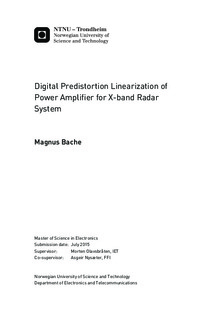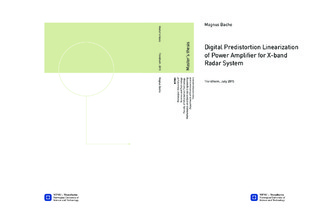| dc.description.abstract | Modern communication systems with advanced modulation schemes have increased the linearity demands of power amplifiers. This thesis investigates the use of behavioral modeling of power amplifiers to perform digital predistortion on a GaN PA from Cree intended as the transmitter PA in an X-band MIMO-OFDM radar system currently in development by the Norwegian Defence Research Establishment (FFI). Predistortion is a technique where the non-linear distortion of the PA is ideally removed by introducing a unit with the inverse distortion characteristics of the PA. The cascade of the predistorter and the PA thus achieves a linear input/output relationship. By linearizing the PA there is potential for higher power outputs without suffering too much distortion which also leads to an efficiency benefit.
In order to perform digital predistortion linearization, a number of behavioral models based on the Volterra series have been used. Behavioral models are mathematical models describing the relationship between the PA input and output. They require no knowledge about the physical structure of the PA, which is advantageous as this information rarely is available. Three models have been evaluated; the memoryless complex power series (CPS) model, the Wiener model and the memory polynomial (MP) model. The models are implemented in MATLAB and used to describe the behavior of two radio frequency power amplifiers with different operating frequencies, the first being a PA designed at NTNU based on the Cree 10W GaN transistor, and the second being the Cree CMPA5585025F GaN PA intended as the transmitter PA in the radar system. Characterization measurements are performed using a 16-QAM signal and by using the indirect learning architecture, the digital predistortion coefficients are calculated and applied to the input signal. Linearization is then performed on both a 16-QAM signal and an OFDM signal. The results show that the adjacent-channel-power ratio (ACPR) and the error-vector magnitude (EVM) of the 16-QAM signal can be reduced by $15$ dB and $5\%$ respectively for the 10W PA at the 1-dB compression point, but only an ACPR reduction of $5$ dB was achieved for the OFDM signal. Linearization of the 25W PA only received an ACPR and EVM reduction of $6$ dB and $3\%$ respectively for the 16-QAM signal, however the ACPR reduction for the OFDM signal surpassed this, achieving more than $10$ dB reduction. The reason for the poorer linearziation performance of the 25W PA was found to be large memory effects leading to less accurate behavioral modeling, even for models incorporating memory. For both of the PAs and signals the linearization performance was quickly reduced as the output power was increased. Thus for higher power outputs, there are less linearization benefits. The results lead to a conclusion that there are not very clear benefits of implementing digital predistortion in the radar system. | |

